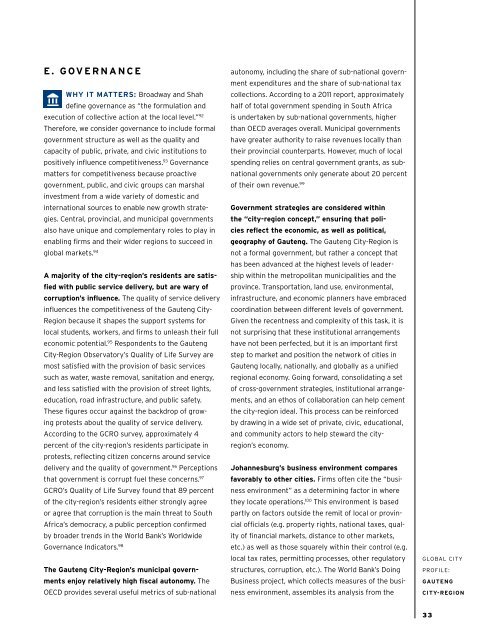SOUTH AFRICA’S
1HAwfit
1HAwfit
Create successful ePaper yourself
Turn your PDF publications into a flip-book with our unique Google optimized e-Paper software.
E. GOVERNANCE<br />
WHY IT MATTERS: Broadway and Shah<br />
define governance as “the formulation and<br />
execution of collective action at the local level.” 92<br />
Therefore, we consider governance to include formal<br />
government structure as well as the quality and<br />
capacity of public, private, and civic institutions to<br />
positively influence competitiveness. 93 Governance<br />
matters for competitiveness because proactive<br />
government, public, and civic groups can marshal<br />
investment from a wide variety of domestic and<br />
international sources to enable new growth strategies.<br />
Central, provincial, and municipal governments<br />
also have unique and complementary roles to play in<br />
enabling firms and their wider regions to succeed in<br />
global markets. 94<br />
A majority of the city-region’s residents are satisfied<br />
with public service delivery, but are wary of<br />
corruption’s influence. The quality of service delivery<br />
influences the competitiveness of the Gauteng City-<br />
Region because it shapes the support systems for<br />
local students, workers, and firms to unleash their full<br />
economic potential. 95 Respondents to the Gauteng<br />
City-Region Observatory’s Quality of Life Survey are<br />
most satisfied with the provision of basic services<br />
such as water, waste removal, sanitation and energy,<br />
and less satisfied with the provision of street lights,<br />
education, road infrastructure, and public safety.<br />
These figures occur against the backdrop of growing<br />
protests about the quality of service delivery.<br />
According to the GCRO survey, approximately 4<br />
percent of the city-region’s residents participate in<br />
protests, reflecting citizen concerns around service<br />
delivery and the quality of government. 96 Perceptions<br />
that government is corrupt fuel these concerns. 97<br />
GCRO’s Quality of Life Survey found that 89 percent<br />
of the city-region’s residents either strongly agree<br />
or agree that corruption is the main threat to South<br />
Africa’s democracy, a public perception confirmed<br />
by broader trends in the World Bank’s Worldwide<br />
Governance Indicators. 98<br />
The Gauteng City-Region’s municipal governments<br />
enjoy relatively high fiscal autonomy. The<br />
OECD provides several useful metrics of sub-national<br />
autonomy, including the share of sub-national government<br />
expenditures and the share of sub-national tax<br />
collections. According to a 2011 report, approximately<br />
half of total government spending in South Africa<br />
is undertaken by sub-national governments, higher<br />
than OECD averages overall. Municipal governments<br />
have greater authority to raise revenues locally than<br />
their provincial counterparts. However, much of local<br />
spending relies on central government grants, as subnational<br />
governments only generate about 20 percent<br />
of their own revenue. 99<br />
Government strategies are considered within<br />
the “city-region concept,” ensuring that policies<br />
reflect the economic, as well as political,<br />
geography of Gauteng. The Gauteng City-Region is<br />
not a formal government, but rather a concept that<br />
has been advanced at the highest levels of leadership<br />
within the metropolitan municipalities and the<br />
province. Transportation, land use, environmental,<br />
infrastructure, and economic planners have embraced<br />
coordination between different levels of government.<br />
Given the recentness and complexity of this task, it is<br />
not surprising that these institutional arrangements<br />
have not been perfected, but it is an important first<br />
step to market and position the network of cities in<br />
Gauteng locally, nationally, and globally as a unified<br />
regional economy. Going forward, consolidating a set<br />
of cross-government strategies, institutional arrangements,<br />
and an ethos of collaboration can help cement<br />
the city-region ideal. This process can be reinforced<br />
by drawing in a wide set of private, civic, educational,<br />
and community actors to help steward the cityregion’s<br />
economy.<br />
Johannesburg’s business environment compares<br />
favorably to other cities. Firms often cite the “business<br />
environment” as a determining factor in where<br />
they locate operations. 100 This environment is based<br />
partly on factors outside the remit of local or provincial<br />
officials (e.g. property rights, national taxes, quality<br />
of financial markets, distance to other markets,<br />
etc.) as well as those squarely within their control (e.g.<br />
local tax rates, permitting processes, other regulatory<br />
structures, corruption, etc.). The World Bank’s Doing<br />
Business project, which collects measures of the business<br />
environment, assembles its analysis from the<br />
GLOBAL CITY<br />
PROFILE:<br />
GAUTENG<br />
CITY-REGION<br />
33


